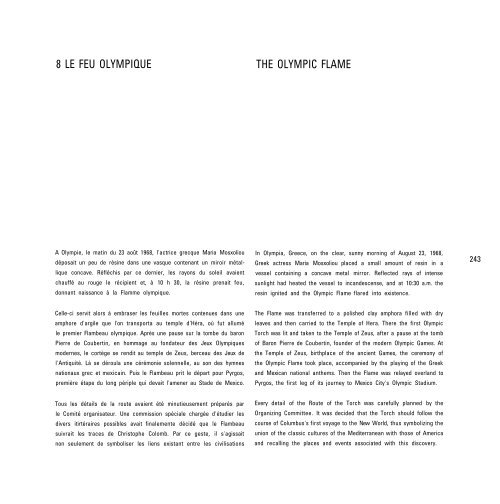Mexico City Olympic Games Official Report ... - LA84 Foundation
Mexico City Olympic Games Official Report ... - LA84 Foundation
Mexico City Olympic Games Official Report ... - LA84 Foundation
Create successful ePaper yourself
Turn your PDF publications into a flip-book with our unique Google optimized e-Paper software.
8 LE FEU OLYMPIQUE<br />
A Olympie, le matin du 23 août 1968, l'actrice grecque Maria Mosxoliou<br />
déposait un peu de résine dans une vasque contenant un miroir métal-<br />
lique concave. Réfléchis par ce dernier, les rayons du soleil avaient<br />
chauffé au rouge le récipient et, à 10 h 30, la résine prenait feu,<br />
donnant naissance à la Flamme olympique.<br />
Celle-ci servit alors à embraser les feuilles mortes contenues dans une<br />
amphore d'argile que l'on transporta au temple d'Héra, où fut allumé<br />
le premier Flambeau olympique. Après une pause sur la tombe du baron<br />
Pierre de Coubertin, en hommage au fondateur des Jeux Olympiques<br />
modernes, le cortège se rendit au temple de Zeus, berceau des Jeux de<br />
l'Antiquité. Là se déroula une cérémonie solennelle, au son des hymnes<br />
nationaux grec et mexicain. Puis le Flambeau prit le départ pour Pyrgos,<br />
première étape du long périple qui devait l'amener au Stade de <strong>Mexico</strong>.<br />
Tous les détails de la route avaient été minutieusement préparés par<br />
le Comité organisateur. Une commission spéciale chargée d'étudier les<br />
divers itirtéraires possibles avait finalemente décidé que le Flambeau<br />
suivrait les traces de Christophe Colomb. Par ce geste, il s'agissait<br />
non seulement de symboliser les liens existant entre les civilisations<br />
THE OLYMPIC FLAME<br />
In Olympia, Greece, on the clear, sunny morning of August 23, 1968,<br />
Greek actress Maria Mosxoliou placed a small amount of resin in a<br />
vessel containing a concave metal mirror. Reflected rays of intense<br />
sunlight had heated the vessel to incandescense, and at 10:30 a.m. the<br />
resin ignited and the <strong>Olympic</strong> Flame flared into existence.<br />
The Flame was transferred to a polished clay amphora filled with dry<br />
leaves and then carried to the Temple of Hera. There the first <strong>Olympic</strong><br />
Torch was lit and taken to the Temple of Zeus, after a pause at the tomb<br />
of Baron Pierre de Coubertin, founder of the modern <strong>Olympic</strong> <strong>Games</strong>. At<br />
the Temple of Zeus, birthplace of the ancient <strong>Games</strong>, the ceremony of<br />
the <strong>Olympic</strong> Flame took place, accompanied by the playing of the Greek<br />
and Mexican national anthems. Then the Flame was relayed overland to<br />
Pyrgos, the first leg of its journey to <strong>Mexico</strong> <strong>City</strong>'s <strong>Olympic</strong> Stadium.<br />
Every detail of the Route of the Torch was carefully planned by the<br />
Organizing Committee. It was decided that the Torch should follow the<br />
course of Columbus's first voyage to the New World, thus symbolizing the<br />
union of the classic cultures of the Mediterranean with those of America<br />
and recalling the places and events associated with this discovery.<br />
243
















